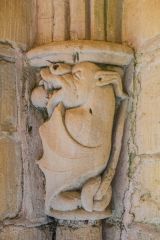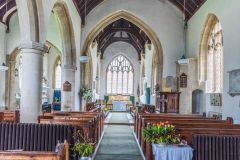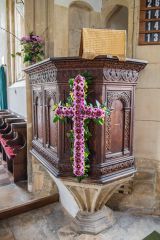
The medieval parish church of St James the Elder stands in an idyllic setting beside the Tudor manor house of Horton Court, just north of the South Gloucestershire village of Horton, near Chipping Sodbury.
History
Much of the church as we see it today dates to the 14th century, but it stands on the site of an earlier 12th-century building and, possibly, a still-earlier Saxon one. We know that a church has existed on this site for over one thousand years.
During the Norman period, the vicar of St James' Church lived in the neighbouring Vicar's Hall, which was later incorporated into Horton Court. It is possible that the vicarage at Horton is the oldest in England.
The present church was begun around the year 1300. It is built of local Cotswold stone, under a stone tiled roof. The only feature of the earlier church to survive is the Norman font, carved in the Norman period (probably 12th century) and recut in the 17th century. The wooden font cover also dates to the 17th century.

The Pastons of Horton
The church has a close connection with the Paston family, former owners of Horton Court. You first notice this connection before you even enter the church; the golden weathervane atop the west tower is in the shape of a griffin, which features on the Paston coat of arms.
Edward VI granted the manor of Horton to his uncle, the Protector Somerset. After Somerset was executed for treason in 1552, the manor passed to Sir Clement Paston, the grandson of John Paston of Oxneade Hall in Norfolk. John Paston was famous for 'The Paston Letters'; correspondence with his wife that is a rich source of material for how late-medieval landowning families lived and worked.
Sir Clement Paston was a naval officer. The crowning achievement of his maritime career was when he captured the French admiral, Baron de Saint Blanchard. The admiral was held prisoner until a ransom of 7,000 crowns was paid for his release. The manor of Horton passed down through the Paston family until the last Paston died died in the early years of the 19th century.
In the north chapel stand two large and ornate marble monuments to generations of the Pastons. The earliest named deceased is William Paston (d. 1673).

The Porch Carvings
You enter the church through the south porch, which has a parvise, or small chamber, above the entrance. The porch roof is supported by a ribbed tierceron vault with a large Agnus Dei (Lamb of God) carving on the central boss.
There are carved jamb shafts in each corner, and the capital of each shaft is decorated with a beautifully crafted carving. The southernmost two capitals depict grotesque beasts, including one that resembles a dragon.
The northernmost carvings (either side of the door) depict men. One appears to be a musician playing some sort of a wind instrument, and the other is clearly a bagpipe player.
Set into the wall beside the southern side of the chancel arch is a rood stair which now leads directly into the wooden pulpit, which dates to the Jacobean period and stands on a 15th century stone base.
On the south side of the chancel is a stone pillar piscina on an octagonal shaft.
All the windows have clear glass except for the east window of the north chapel where fragments of medieval stained glass have been assembled.

Monuments of Interest
Aside from the Paston family monuments mentioned earlier, the most intriguing memorials are three brass funereal plaques. One of these commemorates Anne Barnes, who died in 1730 from complications following childbirth. The plaque also commemorates her daughter, also named Anne, who survived only to the age of three weeks.
Another 18th-century brass plaque commemorates Thomas Walker (d 1717), while the third is to Francis Frankcom (d 1767).
Against the south nave wall is a tablet and small brass plaque to Baron Carlo de Tuyll, whose ashes were transported from California to Horton in 1913 and placed in a recess behind the memorial by his sons and his wife, who later became the ninth Duchess of Beaufort.
Finally, there is a war memorial plaque to three young me of Horton who died in the First World War; Paul Bourdillon of the Royal Engineers, John Iles of the Essex Regiment, and John Whittern of the Royal Hampshire Regiment.
St James' Church stands immediately beside the Cotswold Way long-distance footpath and is a popular stopping place for walkers on the path.

Getting There
From the centre of Horton village take the minor roadnorth, signposted to Hawkesbury and to Horton Court. You will come to the church on a bend in the road after about half a mile. During services there is a large parking area on the left, just past the church, but at other times there is limited parking along the verge, outside the church gates.
St James the Elder was open when we visited.
About Horton, St James the Elder Church
Address: Horton Court,
Horton,
Gloucestershire,
England, BS37 6QR
Attraction Type: Historic Church
Location: North of the village centre, on the Hawkesbury road, beside Horton Court
Website: Horton, St James the Elder Church
Location
map
OS: ST765850
Photo Credit: David Ross and Britain Express
HERITAGE
 We've 'tagged' this attraction information to help you find related historic attractions and learn more about major time periods mentioned.
We've 'tagged' this attraction information to help you find related historic attractions and learn more about major time periods mentioned.
Find other attractions tagged with:
NEARBY HISTORIC ATTRACTIONS
Heritage Rated from 1- 5 (low to exceptional) on historic interest
Horton Court - 0.1 miles (Historic Building) ![]()
Oldbury-on-the-Hill, St Arild's Church - 3.7 miles (Historic Church) ![]()
Kingswood Abbey Gatehouse - 4.5 miles (Abbey) ![]()
Charfield, St James Church - 4.8 miles (Historic Church) ![]()
Newark Park - 5.3 miles (Historic House) ![]()
Dyrham Camp Hillfort - 5.4 miles (Prehistoric Site) ![]()
Ozleworth, St Nicholas Church - 5.5 miles (Historic Church) ![]()
Dyrham Park - 6 miles (Historic House) ![]()
Nearest Holiday Cottages to Horton, St James the Elder Church:
Slimbridge, Gloucestershire
Sleeps: 2
Stay from: £340 - 754
Wotton-under-Edge, Gloucestershire
Sleeps: 6
Stay from: £491 - 1794
More self catering near Horton, St James the Elder Church












